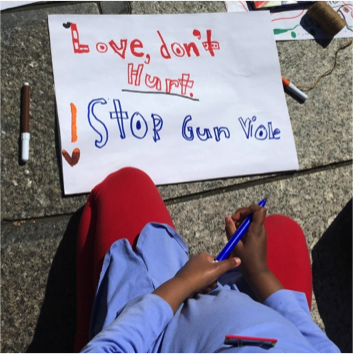Gun violence and mental health
After instances of mass violence, especially widely covered school shootings, mental illness is often identified as—or assumed to be—a root cause. Social science research can help educators understand some simple truths and can challenge some common misconceptions.
Four assumptions regularly shape news media coverage in the aftermath of mass shootings:
- Mental illness causes gun violence.
- A psychiatric diagnosis can predict gun crime before it happens.
- Mass shootings are committed by mentally ill loners.
- Gun control won’t prevent another tragedy, because mass shooters’ psychiatric histories are too complex
In fact, research shows that:
Mental illness does not cause gun violence: “Surprisingly little population-level evidence supports the notion that individuals diagnosed with mental illness are more likely than anyone else to commit gun crimes” (Metzl and MacLeish 2015).
People with diagnosed with mental illnesses are not more likely to commit mass shootings; less than 5 percent of violence can be attributed to mental illness.
In fact, people with mental illness of varying severity—including attention deficit hyperactivity disorder, anxiety, bipolar disorder, depression, post-traumatic stress disorder and schizophrenia—are more likely to be victimized than people without mental illness. They are also more likely to self-harm than to commit violence against others.
A diagnosis of mental illness does not predict gun violence: “Psychiatric diagnosis is in and of itself not predictive of violence, and even the overwhelming majority of psychiatric patients who fit the profile of recent US mass shooters—gun-owning, angry, paranoid White men—do not commit crimes” (Metzl and MacLeish 2015). People who commit mass shootings are not well; as one professor in psychiatry and behavioral health explains: “A mass shooting is the product of a disordered mental process” (Beckett 2014). Those who also feel hopeless, desperate and suicidal are more likely to violate others. Still, shooters rarely have a diagnosed (or diagnosable) mental illness.
Blaming mentally ill loners will not reduce gun violence: Suggesting mental illness is (always or often) the root cause of terrible acts is stigmatizing. Stigma prevents people with mental illness from seeking and accessing appropriate care.
“The minute something happens, they all know all who I am. The people in the schools need to learn that singling someone out just because they’re a little bit different, because they don’t want to talk to people, because they don’t know how to communicate properly doesn’t mean that I’m any different from you. Just because I’m a little different doesn’t mean I’m going to come into school one day with a gun.”
–Owen (Connecticut), student with autism accused of being a threat to his peers
We know the risk factors for perpetrating violence. Several studies have identified a history of childhood abuse, substance abuse and male gender as predictive risk factors for serious violence. More specifically, school shooters are often white adolescent boys from small communities where “everyone knows everyone”; these are often boys who faced gender-based bullying, such as being deemed “unmanly” because of their weight or athleticism, and who have access to guns.
Gun control can help prevent gun violence: Furthermore, schools can reduce everyday violence. Enriching all aspects of a child’s life—learning, development and play—is a long-term prevention strategy that addresses multiple forms of violence. According to one author, that strategy includes “better education, youth services, jobs that pay a living wage, mental health services, trauma counseling, a fair criminal justice system—in short, more opportunity, less despair” (Younge 2018). A whole-child approach by schools does not focus on averting a school shootings, per se, but seeks to ensure every student gets the start he or she deserves.
Learn more
Beckett, L. “Myth vs. Fact: Violence and Mental Health.” ProPublica, June 10, 2014.
Van Brunt, B. “Intervening Early to Stop Killers.” Interview by D. Greene. Morning Edition, National Public Radio, February 16, 2018.
Kim, S. “Autistic Teen Says Peers at Norwalk High Unfairly Label Him a Threat.” The Hour, February 24, 2018.
Letzter, R. “The News Is Telling You a Distorted Story about Mental Illness.” Business Insider, June 11, 2016.
Metzl, J.M., and K.T. MacLeish. “Mental Illness, Mass Shootings, and the Politics of American Firearms.” American Journal of Public Health 105, no. 2 (February 1, 2015): pp. 240-249.
National Association to Advance Fat Acceptance. “Child Advocacy Toolkit,” 2010.
National Association of School Psychologists. “Preventing Mass Violence Requires Access to Mental Health Services and Reduced Inappropriate Access to Firearms.” Statement, February 15, 2018.
Younge, G. “High School Massacres Are Just the Tip of the Iceberg Among Youth Gun Deaths.” Truthout, July 12, 2018.

